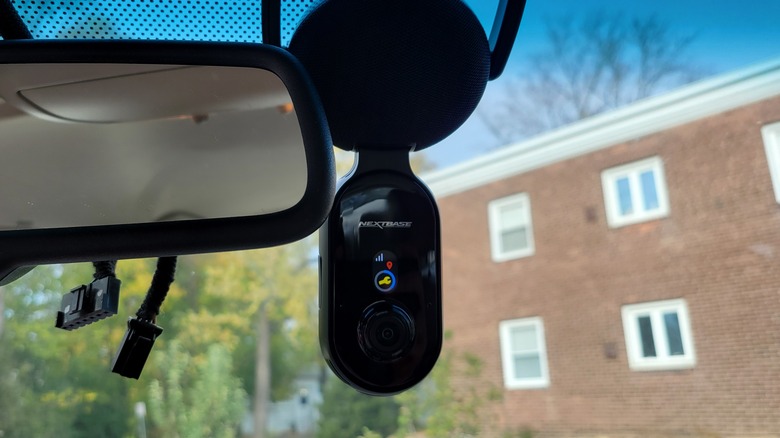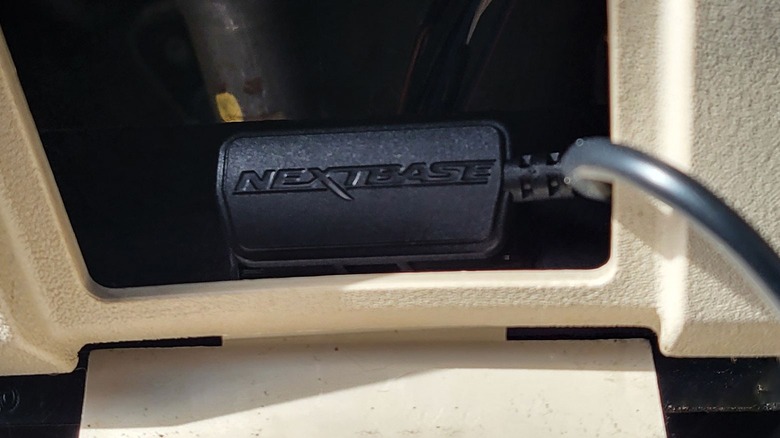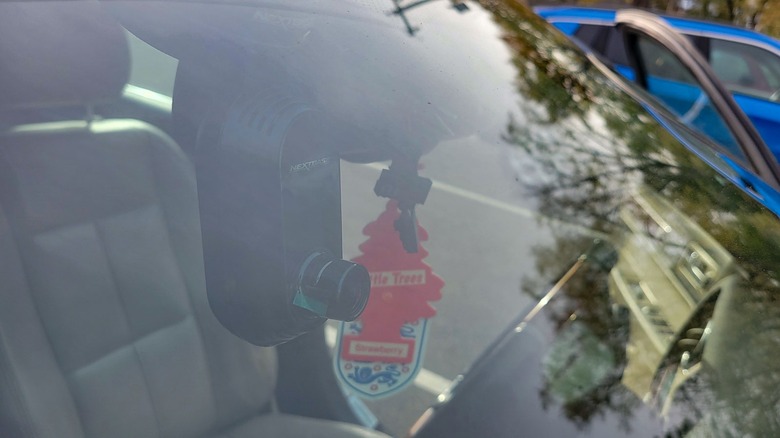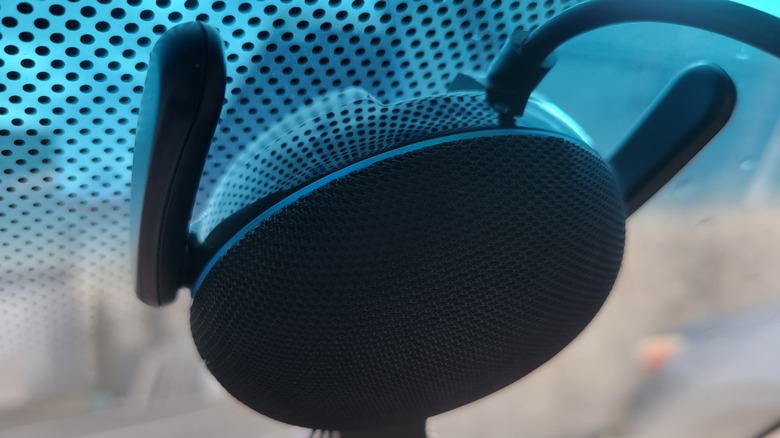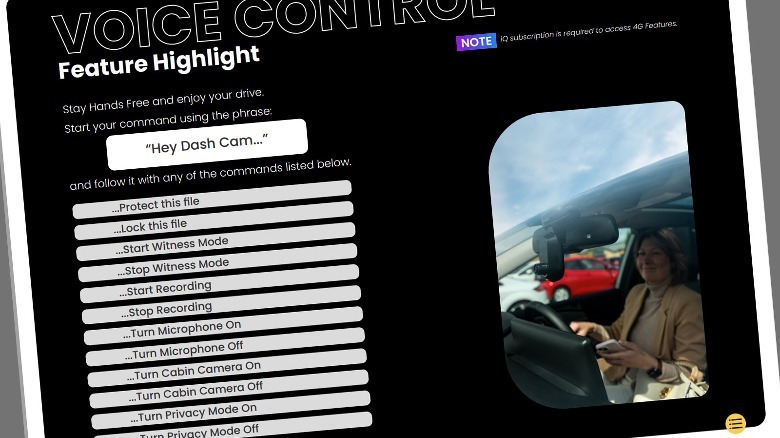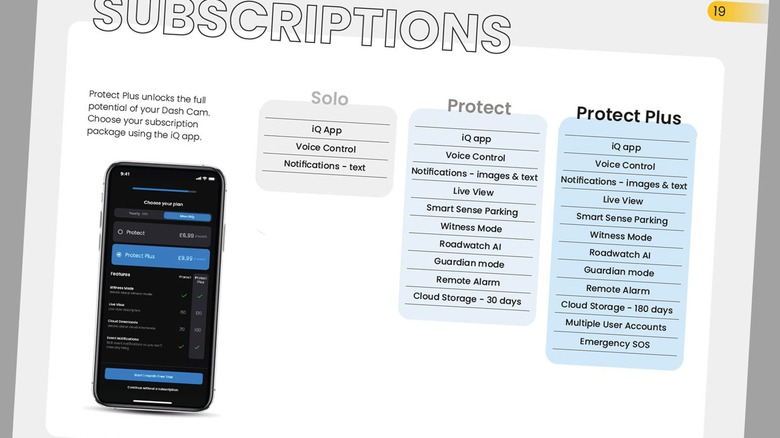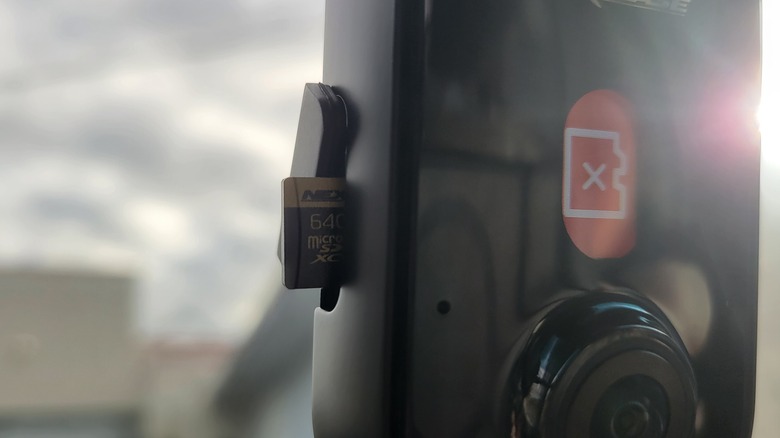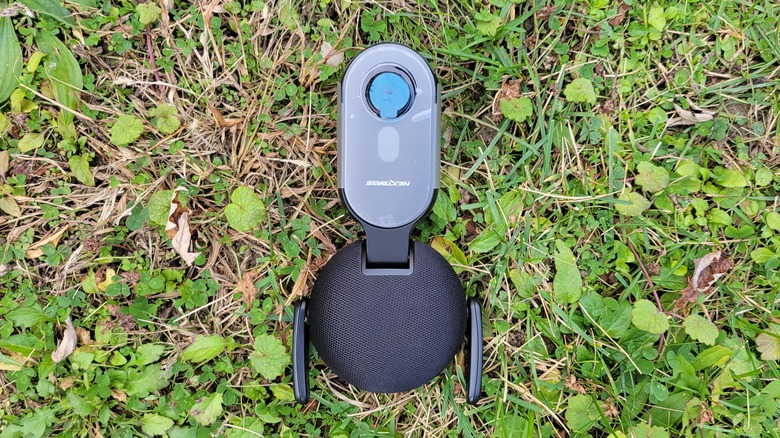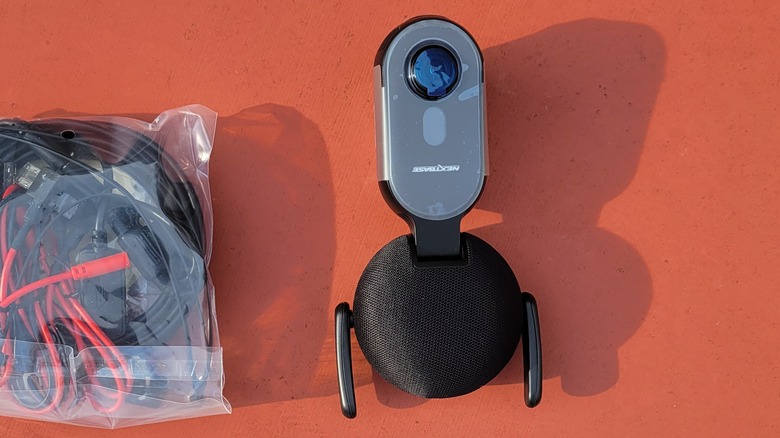Nextbase iQ Review: A Solid Dash Cam, Even With Its Best Features Missing
- Easy setup
- Easy to use
- Superb image quality
- Built in SD card
- Packed with advanced features
- Arguably its best features aren't yet available
- It's quite expensive
We may receive a commission on purchases made from links.
Dashcams are becoming more and more popular, with individuals wanting to decrease the likelihood of blame if an accident isn't their fault and professionals like Uber drivers wanting to reduce liability and protect themselves from passengers. But it's a crowded marketplace, full of big names and feature-packed options. Nextbase, a company that has had a lot of success in Europe, has decided to aggressively enter the U.S. market. With it, it brings an AI-powered webcam that promises to be the most advanced device of its kind available on the market — but is that really the case?
Nextbase is also promising long-term support for its premium dashcam in the form of regular, feature-laden, updates. The first wave is scheduled to come in December 2023, but polish may be added to what's there and more functions might be crammed in for years to come.
The Nextbase iQ comes in three flavors, 1080p, 2K, and 4k respectively. We were sent a sample of the 4K model by Nextbase for the purposes of this review.
Setup is simple
Many dashcams aren't particularly user-friendly when it comes to setup. Sometimes it's a pretty convoluted process, further complicated by bad software and non-functioning apps. That's not the case with the Nextbase iQ. You do still need to download an app, but that's readily available on both the Google Play Store and Apple App Store. The signup process on the app itself is also simple, and you can sign in through Google or Apple, or just make an account with little more information than a valid email address and a password.
As far as physical installation goes, you simply plug the camera into your car's OBD port, prep a piece of windscreen near your rear-view mirror with the included cleaning cloths, and stick it on there with an included adhesive pad. You can then use an included tool to tidy up the wire by poking it between bits of trim. If your vehicle hasn't got an OBD port, or you want to use the port for something else, don't worry. You can also power the camera through your vehicle's fuse box. This may involve more wiring work and is going to be difficult in some vehicles such as those with fuse boxes in the engine bay or trunk, but it is still a handy option. Especially if you're driving an older vehicle.
Finally, the camera will display a QR code on its screen. Scanning this code links it to the app, and it can handle things from there. This includes installing any firmware updates. All in all, we had the Nextbase iQ up and running in around five minutes. This is a lot less trouble than we had with some of its competitors — like the Ring Car Cam.
Positioning is ideal
While some dash cams, as the name suggests, sit on the dash — the iQ doesn't seem designed for that. Instead, you're supposed to place it on the passenger side of the rear-view mirror. This gives it a good view of the road, the car's interior, and the car's windows. You really see the difference with the road view. On some vehicles, mounting the cam on the dash can lead to the hood obscuring a good percentage of the camera's view. This isn't the case when it's mounted high up.
The placement is also handy for OBD port access, even if your port is in an obscure location like the one in the Lincoln MKZ we tested it in. The biggest challenge with our oddly placed port was finding bits of trim to poke the wire through.
It's also out of the driver's line of sight, and unlikely to cause a distraction. You have to actively look at it to notice it's there. The adhesive pad it comes with is of good quality, and if you use the provided cleaning wipes before attaching it, the camera should be in position for a long time. If you do have to remove it, you're unlikely to damage the hard glass of the windshield. Dashboards are often coated in softer materials, so can be left scarred when you stick things to them.
The app is solid
Another huge plus in the iQ's favor is the quality of the app. In addition to the initial setup, the app is the easiest way to get the most out of the dash cam. Everything is laid out easily, and Nextbase manages to fit a lot onto the screen without things becoming obtrusive. The live view includes a map with the location of the vehicle, a view of the interior (if privacy mode is disabled), and a view from the rear camera if you have one.
All of the camera's functions can be accessed through the app, which also seems to install firmware updates on the camera when those are needed. You can also use said app to tune said functions. If the "smart sense parking" mode is a little too sensitive, or not sensitive enough, for your liking — you can fine-tune its range. If you share a car, and a push notification every time someone gets in said car is a bit much for you, these can be disabled. And so on. If you want to review the footage the camera has taken, you can scroll through it and view any particular incidents that intrigue you.
Beyond the strong functionality, just having something that actually works is a bit of a relief. There are times when we've reviewed otherwise solid products that are let down by an utterly horrendous app. The iQ app gets the basics right — and goes beyond. Hopefully, that continues as time goes on.
Image quality is fantastic
Each of the cameras on offer is HD, so you're unlikely to have a poor-quality experience. The same coding also seems to be behind all three of them, so any AI sharpening type magic or adjustment will apply to all of them — though there may be more wiggle room with the higher-end devices due to the better hardware.
We reviewed the 4K version specifically, and we found the images it recorded to be very clear in both day and night shots. The biggest difference with the higher-end camera is its field of view. Far more is in focus than you're likely to get from a lower-resolution model, which helps if the cause of an accident is coming from an angle. The 4K version also has a higher-quality infrared camera pointing inwards, so your nighttime shots of the car's interior will look sharper.
The bit that really stood out for us was the quality of nighttime footage. It's a good amount sharper than pretty much any other dashcam we've encountered. It's also a bit of a challenge as not only is there little light to work with — but there is too much light at the same time courtesy of headlights, signs, and streetlights. The iQ handles it all exceptionally and somehow pulls usable footage from a nighttime drive.
Voice commands take a little practice
When you're in the car, many of the iQ's functions can be enabled or disabled via voice command. This includes "privacy mode" which will turn off the microphone and interior camera, and "Witness Mode" which will automatically record and upload a 30-minute block of footage and protect a particular file so it won't be overwritten.
Example voice commands are outlined in the camera's manual, which can be downloaded as a PDF from the Nextbase website. Studying that list is recommended, as voice commands are pretty important when it comes to navigating the device and the dash cam is pretty picky. In our experience, the trigger words "Hey dash cam" worked consistently, while things like Hey IQ, IQ, and dash cam did not. You also have to speak fairly purposefully for it to listen. Then there are the commands themselves, which have to be worded quite specifically. Don't go into this expecting a voice activation system on par with something like Siri or Alexa.
With that being said, this is one of the areas where the dash cam may improve in the future. As we've seen with smart home assistants, an update can easily iron out any issues and make the experience a lot smoother. Given the dash cam's specific task, and how central voice commands are to its functionality, it would be pretty surprising if this wasn't an area Nextbase was constantly attempting to polish.
You'll need a subscription to get the most out of it
All of the features beyond very basic things live recording, voice control, and text notifications require some kind of subscription. The subscription currently comes in two tiers, priced at $9.99 and $19.99 per month, respectively. Discounts, and extended warranties, are available if you opt to pay annually. Both plans also include the LTE service that keeps the device online. This service isn't tied to a particular provider and instead uses whatever will give it the strongest signal.
The cheaper package, priced at just under $10 per month, offers a lot of value. You get three months of cloud storage, image notifications, and "smart sense parking" which monitors your car for potential dangers while it's parked. There's also "Witness mode" which, when prompted, will save and upload a 30-minute block of footage to the cloud. There's also the "live view" feature which will allow you to look through the iQ's interior and exterior cameras live, along with an alarm mode you can use to scare off potential thieves and/or vandals.
Protect Plus is the more expensive of the two options, but it comes with six months of cloud storage and what is arguably the camera's most useful feature. Emergency SOS automatically dispatches help if you're involved in an accident. It's one of those "it could save your life" features and could make all the difference if you're rendered incapable by a crash. It is worth noting that this isn't a feature unique to the iQ, but Nextbase has implemented it well. Unlike the iPhone or Apple watch, it doesn't require confirmation before dispatching help. This is due to the far lower risk of a false positive. It's also significantly cheaper than services like OnStar's Guardian.
It has an SD card, if you like to keep it simple
If you don't want to mess around with downloads or want to avoid paying a subscription fee, you can use the Nextbase iQ in a somewhat old-fashioned manner. It comes with a 64GB SD card, with upgrade potential. Files are stored on the card on a rolling basis, so if you need to pull a recording of an incident that happened you can take out the card, pop it in a PC, and you're good to go.
You can't just throw any card in there, with Nextbase stating you need a U3 card with a 100mb/s write speed at minimum. The company does make its own, which come in a number of sizes up to 256 GB and are tested for up to 3,000 write cycles. Either way, if your subscription lapses or you're taking a break — the iQ will still function as a basic dash cam. You won't even need an LTE or WiFi connection to get vital files from it.
Subscriptions and the cloud storage that comes with them become more vital the better your webcam is. As you may be aware, 4k footage takes up a lot of space, as a result even a larger SD card will only be able to store a couple of hours of footage. Scaling down the resolution isn't an option either, so whether or not you'll rely on the SD card should be as much a consideration as price when choosing exactly which webcam you want.
It's very alert to thieves
One of the things you can tinker with in the app is a sort of proximity sensor. When someone gets within its threshold, the camera will wake up. If they get closer or linger for a suspicious amount of time then recording will start and your Nextbase iQ will send you an alert.
This is one of the features that will be enhanced in the near future when the "Push to Talk" function is made available. At that point, you'll be able to speak through the dashcam and warn off the potential thieves. For now, it's still pretty handy as it will record any potential vehicular intruders, and allow you to alert the police as soon as an incident happens. Assuming the thief is there to steal your car and isn't smart enough to disable the Nextbase iQ, its GPS function will also track your vehicle's location — allowing you to supply authorities with even more information.
Beyond the recording, the camera's flashing red ring may be enough to alert thieves to the fact they're being recorded and prompt them to head off to an easier target. Given the cost of replacing a window, or in some cases the whole car, it may be a solid investment if you live in an area with high car crime.
There's a lot more on the way
Many of the Nextbase iQ's most tantalizing features aren't accessible yet. They're still being developed, and are set to go live via over-the-air update in mid-December 2023. These features include "Guardian Mode" which sends an alert if the vehicle's occupant is speeding, driving erratically, or has entered a certain area. Push to Talk, which allows anyone with the app to see what is happening and speak through the camera. This could be handy if a loved one is involved in a crash or traffic stop and unsure of what to do.
Apparently, the camera will also have the ability to send encrypted incident reports to your insurance provider automatically. Nextbase is currently in talks with several insurance companies, and this could help push deals over the line. There's a chance that owning an iQ could net you a significant insurance discount in the future. Then there are some quality-of-life features, like "Roadwatch AI," "Driver Aware," and "Vehicle Aware," which will track hazards on the road and may end up functioning like driver assistance tools in more modern cars. Some of the Protect Plus plan's premium features, like multiple accounts and automatic backup, aren't available yet either.
It's also worth noting that this is only what's been announced so far. Nextbase has singled out the iQ as an "evergreen product" and promises to drop new and more advanced features on it as time goes on. If they hold to this, their high-end dashcam may stay at the cutting edge for a very long time.
It's very good, but feels a little early access
While you're paying top-end money for the Nextbase iQ, it is a top-end dash cam. The video quality alone sets it apart from some of the cheaper options, and that could make the difference between a piece of vital evidence, and a few frames of blurry nonsense. The quality really stands out at night, which is arguably a time when you're more likely to get into trouble.
Beyond the obvious dash cam benefits, the iQ's ability to keep your vehicle safe from thieves is another huge bonus, as is its habit of alerting you when a vehicle is entered or parked. It's simple to set up, and once you have the voice commands memorized easy to use. All in all, it hasn't done much wrong.
But given what Nextbase is claiming, we're yet to truly see the best from this dash cam. An insurance discount may take the sting out of both the price and subscription, while features like "Guardian Mode," "push to talk," and "Roadwatch AI" will elevate it way beyond anything currently on the market. As things stand, it's very good. But if we revisit this review in a few months or so's time, there's a chance we'll be talking about a truly awe-inspiring piece of tech.
Listed on Amazon, the Nextbase iQ is available for sale in three different iterations, one each for 1080p, 2K, and 4k resolution capture. The price difference between each is $100, with the "cheapest" model starting at $499.99, and the others priced at $599.99, and $699.99 respectively.
